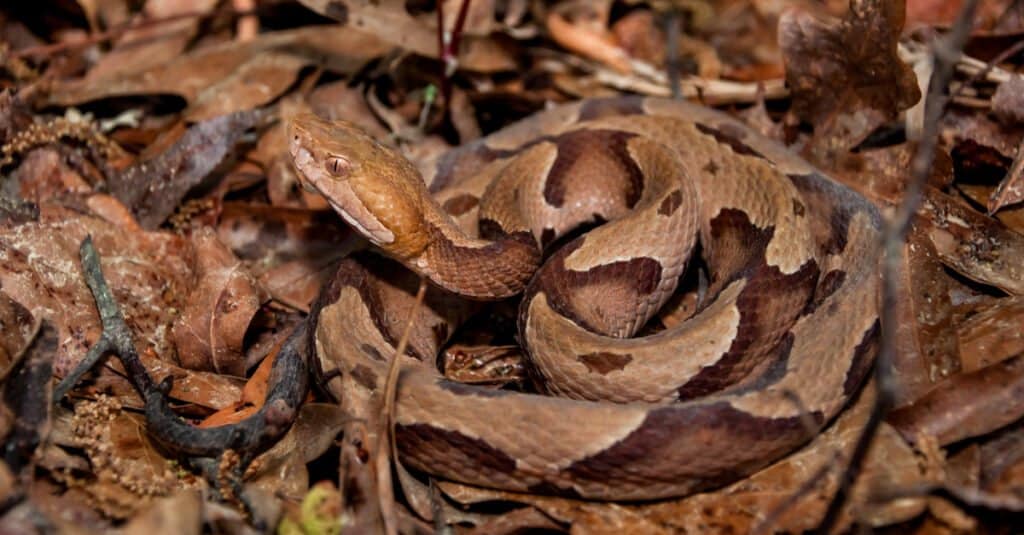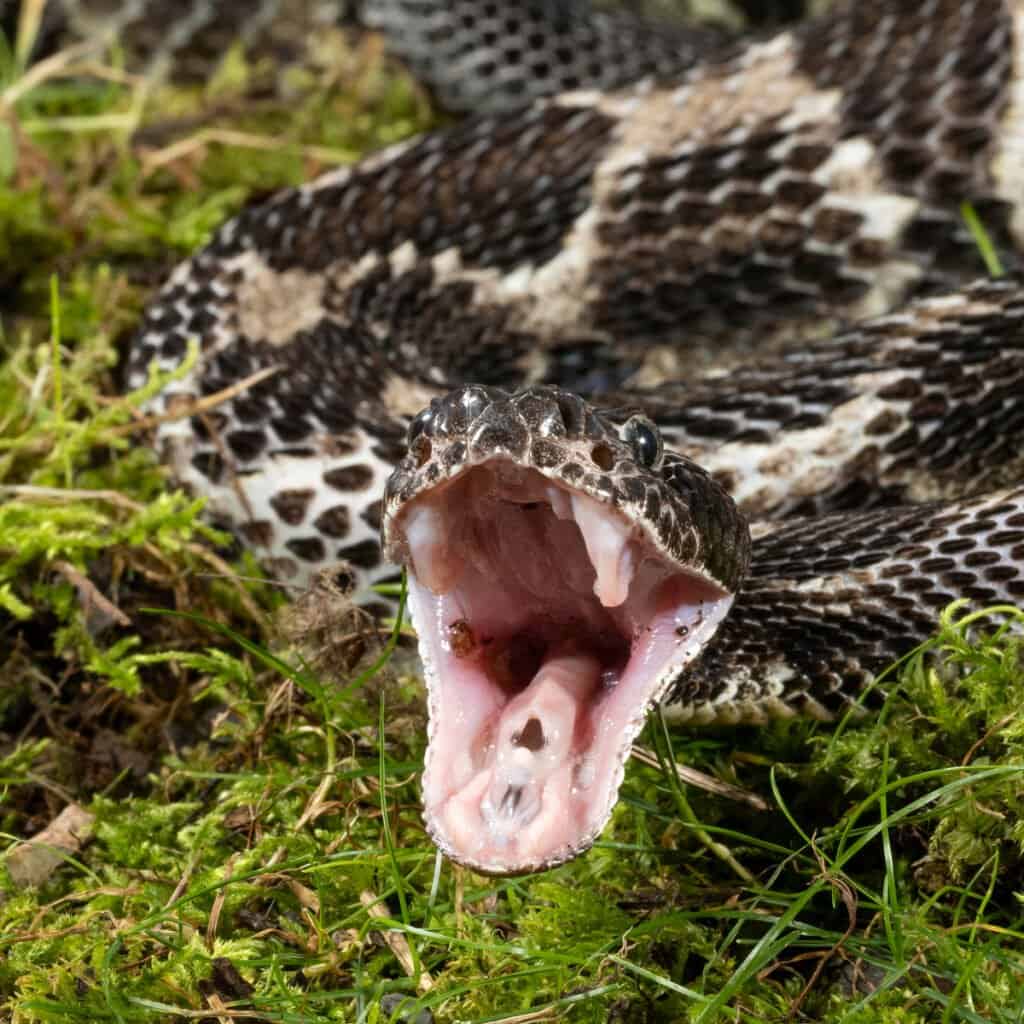Copperheads are some of the most well-known snakes across the United States, especially in the southeast. These coppery snakes are common visitors in backyards across the year, but are they dangerous? Today, we are going to take a closer look into the territory of these snakes and learn just how often they are actually posing a risk. Let’s discover: Copperheads in Connecticut: Where They Live and How Often They Bite!
Do copperheads live in Connecticut?

There are two species of venomous snake in Connecticut, including the copperhead.
©Jay Ondreicka/Shutterstock.com
Copperheads live across the entire state of Connecticut.
Aside from rattlesnakes, copperheads are among the most common of all venomous snakes in North America. Generally, their range includes all of the southeastern portions of the States, with a northerly border around New York and Vermont, including Connecticut.
Although it seems contrary to what many think, snakes can survive pretty far north. Connecticut is all the way up in New England, but that doesn’t mean there aren’t some scaly visitors who may slither by!
Identifying a Copperhead

There are three subspecies of copperhead across the states.
©Jeff W. Jarrett/Shutterstock.com
Historically, five species of copperhead were identified across the United States. Today, after DNA analysis and further research, only three remain. The three subspecies are the Eastern copperhead, the broad-banded copperhead, and the Trans-Pecos copperhead. Still, despite all their differences as subspecies, they are nearly identical and clearly identified together. The subspecies of copperhead that lives in Connecticut is the eastern copperhead, formerly recognized as the northern copperhead.
Eastern copperheads can be recognized by their dark brown hourglass markings overlaid on a coppery background. The thinnest portion of the hourglass shape is placed on the snake’s spine, with the larger segments along the sides. Although they generally have the standard copper base color, they also come in shades of dark brown or reddish-brown.
Aside from colors, copperheads have other features to identify them by. Their heads are triangular and pointed, and their eyes are usually light tan or a bright golden yellow. Additionally, copperheads have heat-sensing pits located between their eyes and their snouts, classifying them as pit vipers (alongside rattlesnakes and water moccasins).
Where do copperheads live in Connecticut?
There are populations of copperheads spread through the entire state of Connecticut, but there are certain regions with a higher population density. The greatest number of copperheads are generally found around the Central Connecticut Lowland ridges, around the western side of the Connecticut River.
Although some transient individuals may be found elsewhere, they are quite rare in the northwestern and northeastern portions of the state. Copperheads have a stable population across the state, while the only other venomous snake, the timber rattlesnake, is currently threatened.
What kinds of habitat do copperheads prefer?

Copperheads generally prefer wooded, hilly, and rocky regions.
©iStock.com/David Kenny
The exact habitat preferred by a copperhead depends on the region it lives in. In Connecticut, copperheads seem to prefer hilly, low-lying regions. As a general rule, however, copperheads can be found near water sources. Other common habitats include woodlands, basalt ridges, talus slopes, rocky hillsides, and meadows.
During the winter, you most likely won’t encounter a copperhead. Snakes in the north go into a special state of hibernation known as “brumation,” where their core body temperate drops, and they hide underground, usually in a den. Copperheads are most active in this region from April to October, depending on the weather. After October, they head underground to brumate.
How dangerous are copperheads?

Copperheads are venomous, but the vast majority of bites only result in temporary symptoms.
©Dennis W Donohue/Shutterstock.com
The state of Connecticut has two venomous snakes, the copperhead and the timber rattlesnake. Between the two, the timber rattlesnake is significantly more dangerous. Although copperhead bites are among the most common venomous snake bites in the US, they aren’t all that dangerous.
Copperheads are members of the pit viper family, along with rattlesnakes and cottonmouths. Of them all though, copperheads have the least dangerous venom. Even more, copperheads don’t like biting people and prefer to stay hidden and camouflaged. Still, accidents do happen, and bites occur.
If you are bitten by a copperhead, common symptoms include pain, tingling, throbbing, swelling, and severe nausea. Most symptoms occur immediately, and medical attention is required. Thankfully, people rarely, if ever, die from copperhead bites, especially if they receive medical treatment shortly after.
How often do copperheads bite people?
In states where the copperhead is present, they are the most common venomous snake bites. Nationally, roughly 3,000 people are bitten by copperheads yearly, with the fatalities being statistically insignificant. In most cases where a death occurs, it is due to an allergic reaction to the venom, not from the standard interaction that the venom is intended to cause. The official incidence of bites across the population is about 16.4 bites per million people annually.
Which U.S. State Has the Most Snake Bites?

The venomous timber rattlesnake is among those responsible for snake bites in North Carolina.
©Joe McDonald/Shutterstock.com
While Connecticut does have venomous snakes slithering about, the amount of snake bites annually is a drop in the bucket compared to some U.S. states. So which state ranks the highest in snake bites? That would be North Carolina. The snake bite rate in this southeastern state is 157.8 bites per million population annually. As the population as of 2021 was a little over 10 million (10.55 to be exact), and we were to just figure it off of 10 million, that would average out to roughly 1,580 reported snake bites per year.
The top 6 states for reported snake bites are:
| Rank | State | Bites per Million |
|---|---|---|
| 1 | North Carolina | 157.8 |
| 2 | West Virginia | 105.3 |
| 3 | Arkansas | 92.9 |
| 4 | Oklahoma | 61 |
| 5 | Virginia | 48.7 |
| 6 | Texas | 44.2 |
There are 6 different kinds of venomous snakes inhabiting North Carolina: copperhead, cottonmouth, eastern coral snake, eastern diamondback rattlesnake, pigmy rattlesnake, and timber rattlesnake. In the year 2019, there were 92 people bitten by venomous snakes in that state.
Discover the "Monster" Snake 5X Bigger than an Anaconda
Every day A-Z Animals sends out some of the most incredible facts in the world from our free newsletter. Want to discover the 10 most beautiful snakes in the world, a "snake island" where you're never more than 3 feet from danger, or a "monster" snake 5X larger than an anaconda? Then sign up right now and you'll start receiving our daily newsletter absolutely free.
Thank you for reading! Have some feedback for us? Contact the AZ Animals editorial team.








